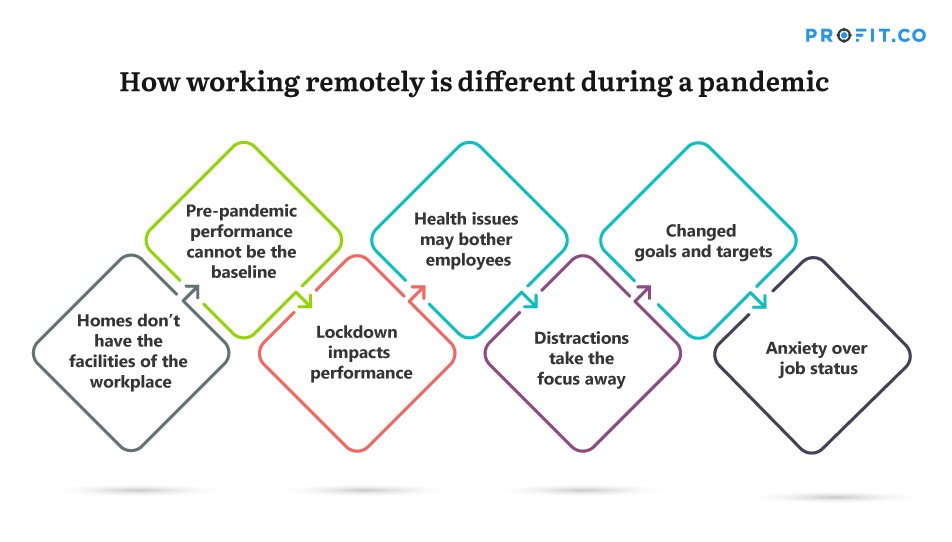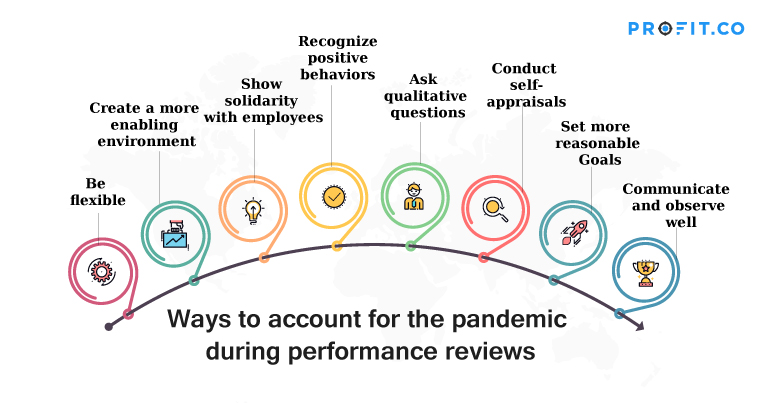Employee performance reviews are the key to ensuring that employees are on track to achieve their goals. Companies need to conduct reviews periodically to understand how the performance and progress of individual employees contribute to the growth of the organization. Without reviews, organizations may lose their way and move away from their goals.
Conducting performance reviews during a pandemic
Even on any normal day, reviews can be taxing for the managers and can give employees anxiety, as they bring in an element of scrutiny and can make or break an employee’s career. In times of a global pandemic,

conducting reviews has become even more challenging. After the Covid-19 pandemic, things have changed significantly. Work-from-home is the norm now, and there is no precedent for conducting performance reviews remotely. So, it is important to carefully consider the implications of prolonged remote working conditions that the employees face before planning a review.
Appreciate everything your associates do for the business. Nothing else can quite substitute for a few well-chosen, well-timed, sincere words of praise. They’re absolutely free and worth a fortune.
How working remotely is different during this pandemic?
Work-from-home is not entirely new. People have been working from home or from a remote location since ages. But it was a short-term solution then. Regular employees never worked from a remote location for a prolonged period without visiting the workplace. So, working from a remote location on a normal day is completely different from working remotely during a pandemic. Working from home during the pandemic can have a drastic impact on performance. So, it is crucial to take into account the following factors when conducting a remote performance review.
Factors To Consider Before Conducting a Remote Performance Review during the Pandemic

1. Homes don’t have the facilities of the workplace
Before the pandemic, most of the employees worked from the company’s premises. So, the normal day-to-day operations at the workplace would go on like clockwork, backed by the staff, infrastructure and facilities. Employees had all the resources at their disposal to perform at the highest level possible. Team meetings, brainstorming, training, etc, were a breeze. But now, most of the employees are locked inside their homes, stuck with a minimalistic work setup. They remain isolated and have to rely on technology to communicate with their team in a virtual space. Any training or professional development is limited to interactive online sessions. So, employees do not have everything they need to perform to the best of their abilities.
2. Pre-pandemic performance cannot be the baseline
The ability to adapt to these new working conditions differs from one employee to another. Also, employees are enduring different problems of varying severity. As a result, the performance level of the employees compared to their respective pre-pandemic reviews may be vastly different. So, it is not advisable to keep their pre-pandemic performance as a baseline for comparison.
3. Lockdown impacts performance
The routine that involved going to a workplace, interacting with colleagues, working together with the team and getting back to their homes at the end of the day helped employees find a balance in life and enabled them to work at their fullest potential. Staying indoors and staring at a computer screen throughout the day has an impact on mental health, and employees may find it hard to perform to the best of their ability.
4. Health issues may bother employees
Even if employees remain healthy, when they have to worry about the health and wellbeing of people they love, it can have a significant impact on work.
5. Distractions take the focus away
The line between home and workspace is completely erased, and the employees find themselves working amidst the distractions at home. From children wanting their attention to the sounds from the immediate surroundings and the neighborhood, there are numerous distractions to take the focus of employees away from work, thus reducing their performance.
6. Changed goals and targets
The post-pandemic market conditions have completely changed. Some sectors see themselves working overtime to meet the demands, while some find a drop in demand for their products and services. So, the targets for every employee may change according to the constant rise or fall of demand in these uncertain times. Setting goals and working towards them requires a lot of flexibility and planning.
7. Anxiety over job status
Millions of people around the world have lost their jobs in the last few months. So, reviews can instill fear in the minds of the employees.
A review can be fair and objective only when it takes into account all these factors. Following are some of the ways in which you can address these concerns in your performance appraisal.

1. Be flexible
The pandemic has made life difficult for everyone, some more than others. So, it is essential to be more empathetic when assessing the performance of the employees. Giving bad ratings without considering their problems can place additional burden on them. It will not only affect their morale, but also result in greater drop in performance. So, you can be more lenient and flexible when rating your employees. Recruitment, training, and onboarding are some of the highest staff expenses on a company’s books. This is why it’s vital for us to understand why employees leave their jobs With continuous conversations, employees feel recognized, rewarded, and supported– subsequently improving employee retention at your company.
2. Create a more enabling environment
Since there are so many factors that can impact on the performance of the employees, it is extremely crucial to ask about the working condition of the employee and the circumstances that led to the poor performance. You can work with them if possible to fix those issues. It will give the employees peace of mind about their job security and create a more enabling environment for them to perform better.
3. Show solidarity with employees
In the end, the purpose of the review is to strengthen and sharpen the workforce. Say positive things and stand with the employees regardless of how they perform. Show them that the organization will support them in these times. Strengthen your rapport with the employees and earn their trust.
4. Recognize positive behaviors
Appreciate even the tiniest and the least significant efforts your employees put into the work, be it their willingness to coordinate with other members to get work done, or brainstorming with the team for ideas. Acknowledge the effort they put in to reach every milestone and reward them wherever due. Employee morale can’t be understated as a driver for improved performance, which is why you need to prioritize morale-boosting measures in your organization if you’re looking to keep employees engaged and satisfied.
5. Ask qualitative questions and listen
Qualitative questions make a good review in the best of times. During the pandemic, it is better to double up on that and give employees the space to voice out their concerns. It is better to avoid ranking and numerically quantifying the performance of the employees, not only because it can be counter-productive, but also because it can be inaccurate. Since every employee may have different problems of varying severity, the performance numbers can greatly differ from what he or she can actually achieve.
6. Conduct self-appraisals
In the absence of similarly equipped work desks and same working conditions, performance has to be assessed on an individual basis without any comparison or bias. In these circumstances, the best person to evaluate an employee is the employee themself. Conduct self-appraisal and let the employees be self-critical and take ownership of their performance.
7. Set more reasonable goals
Since pre-pandemic appraisals are not valid reference points for an employee’s current performance level, it is important to evaluate the capabilities of every employee and set more realistic goals accordingly.
8. Communicate and observe well
Since communication is restricted to online meetings, while reviewing an employee one-to-one, communicate clearly, observe his or her body language and listen to him or her carefully. Clear any misunderstanding and avoid lack of clarity and miscommunication.
Performance Appraisals in Profit.co
Performance reviews conducted in the Profit.co software make it simple to get comprehensive, detailed reports of employee progress and perspective without relying completely on quantitative measurements that don’t account for specialized circumstances.
There are two types of reviews in the Profit.co software– standard reviews and affinity-based reviews. Standard reviews allow HR administrators to customize reviews with open-ended questions so that employees have ample opportunity to describe their experience and perspective on their performance during the review period. This gives the opportunity for employees to self-reflect and self-report on their performance and progress. Here, they have the opportunity to communicate their struggles and their strengths throughout the review period.
Affinity-based performance review asks reviewed employees, managers, and any selected peer reviews to rate an employee’s competencies— skills or attributes necessary for professional success. This 360-degree review method can offer multiple perspectives on employees and can help managers get a full picture of an individual’s skills within the workplace. This type of review is especially useful, as it speaks towards an employee’s attributes, and not just their output. This method can help managers and HR administrators recognize and appreciate an employee’s attitude, bandwidth, and effort during the review period.

